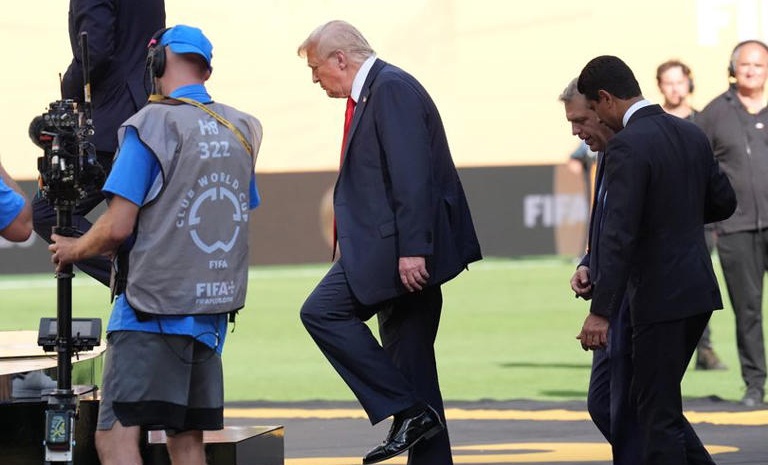Recent images of U.S. President Donald Trump sporting a bruised right hand and visibly swollen ankles have ignited widespread speculation about his health.
The photos, captured at the FIFA Club World Cup finals at New Jersey’s MetLife Stadium, where Trump appeared alongside First Lady Melania Trump, quickly spread across social media.
This prompted questions and concern from both the public and political observers.
In response, the White House issued a statement Thursday seeking to calm public anxieties.
According to a letter from the President’s physician, Trump has been evaluated by a medical team and diagnosed with chronic venous insufficiency.
This is a circulatory issue that affects blood flow in the legs.
The physician emphasized that the condition is benign, and that the President’s overall health, including cardiovascular function and structural assessments, remains within normal parameters.
White House Press Secretary Karoline Leavitt addressed the media on the matter, reiterating that Trump’s heart health is sound and describing the hand bruising as a result of “minor soft tissue irritation.”
According to her, it is likely caused by frequent handshaking and regular use of aspirin, a common medication in preventive cardiovascular care.
Despite this clarification, the online frenzy had already gained momentum.
Viewers watching Trump at the football match noted that his ankles appeared swollen.
The speculation intensified on Tuesday when, during an outdoor press briefing, media cameras caught what appeared to be a concealed bruise on Trump’s right hand, seemingly hidden under a layer of skin-toned makeup.
The footage fueled further rumors, prompting questions about transparency regarding the President’s health.
In light of the attention, Trump underwent a full medical evaluation earlier this week.
According to Leavitt, the check-up confirmed that the President’s vital signs and cardiac function are stable.
Also, the swelling in his lower extremities is linked to his diagnosis of chronic venous insufficiency (CVI), a condition that tends to affect older adults.
What Is Chronic Venous Insufficiency?
Chronic venous insufficiency is a vascular condition in which veins in the legs are unable to efficiently transport blood back to the heart, often due to weakened or damaged vein walls and valves.
This leads to blood pooling in the legs, which increases pressure in the veins and can result in swelling, skin discoloration, and discomfort.
According to the Cleveland Clinic, CVI can affect several types of leg veins:
-
Deep veins, which lie within the muscles and are responsible for moving the majority of blood back toward the heart;
-
Superficial veins, which are located just beneath the surface of the skin;
-
Perforating veins, which connect the deep and superficial systems and help coordinate blood flow.
CVI is common in older adults, particularly those over the age of 70.
Risk factors include aging, sedentary lifestyle, obesity, previous leg injuries, and blood clots.
While the condition typically starts with mild symptoms such as swelling, aching, or visible varicose veins, it can escalate and lead to complications like skin ulcers or infections if not managed properly.
Medical professionals stress that while chronic venous insufficiency may interfere with day-to-day comfort and mobility, it is generally not life-threatening.
According to them, it can often be managed with conservative treatment, such as compression therapy, leg elevation, exercise, and medication.
In more severe cases, surgical interventions may be required.
Public Scrutiny and Political Optics
Trump’s visible symptoms, coupled with the viral nature of social media commentary, have again placed the health of America’s oldest-ever president in the spotlight.
At 79, Trump is under constant scrutiny, especially as he continues to prepare for a potential reelection campaign amid a deeply polarized political climate.
While the administration’s prompt medical transparency aimed to quash rumors, critics argue that visual signs of physical discomfort, such as bruising and swelling, inevitably spark questions about fitness for office.
Still, Trump’s team maintains that the President remains healthy and capable, pointing to clean medical evaluations and ongoing engagement with official duties.
For now, medical experts and political commentators alike will be watching closely, both for updates on his condition and for any signs of escalation or complications.
But with the current diagnosis categorized as benign and non-urgent, the White House appears confident that the issue will not hinder Trump’s ability to govern.



